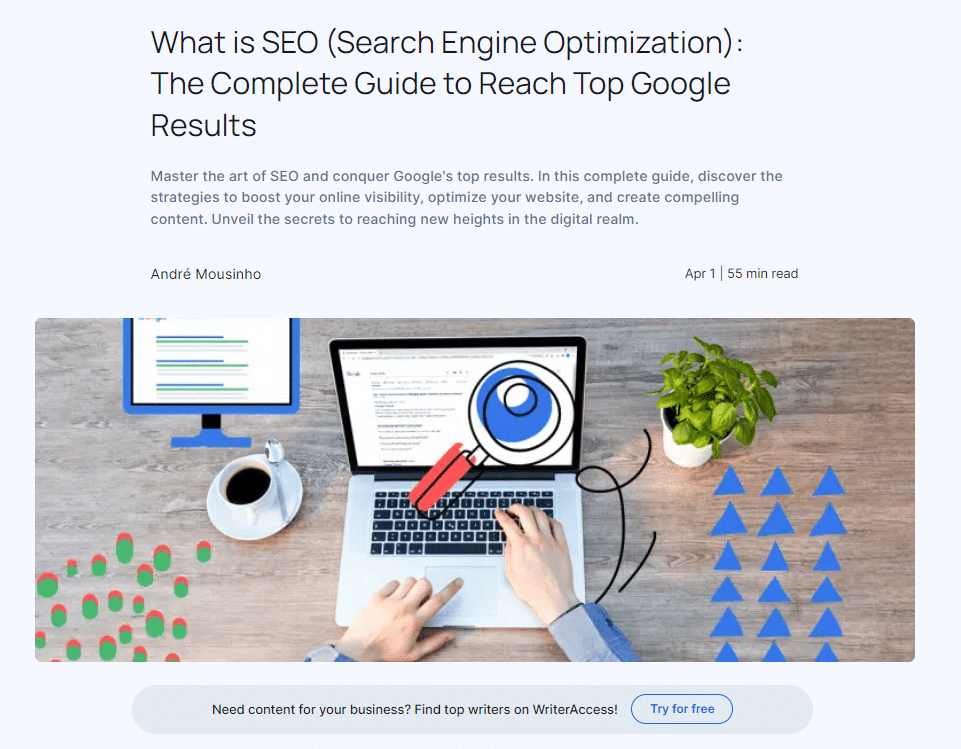No products in the cart.
Content Marketing
Cornerstone Content: What Is It and How to Use It Efficiently?
Regardless of whether you offer services or products, finding ways to stand out, draw traffic to your website, and attract loyal customers can be an ongoing challenge.
One way to achieve all three of these goals is to provide the best cornerstone content possible for your particular brand or business.
This content marketing approach doesn’t only benefit current customers; it can help get you noticed by search engines.
According to recent research, three out of 10 users are dissatisfied with the results that Google initially returns for a query. This is your chance to raise the bar and create content that will better address their wants, needs, or pain points.
Put more simply, by focusing on what will be the cornerstone of your content marketing strategy, you can help Google and potential customers find you faster.
So, what are we really talking about here? What is cornerstone content, why is it beneficial to SEO, and how can you excel at creating it?
What is Cornerstone Content?
Broadly defined, cornerstone content is the foundational high-level, high-quality content that showcases what makes you unique.
It serves two important purposes—to establish your area of expertise and to thoroughly answer specific questions from search engine users.
Your products or services will be secondary here. But, if you do it right, they will also see a boost in attention and potentially higher sales.
Your cornerstone content will be an important part of your SEO strategy as well.
Even if your identified keywords are already commonly found online, it is the content surrounding those keywords and phrases that can get you noticed and boost your search rankings. Make it comprehensive.
Within this comprehensive content, you will also need to develop a natural linking strategy, letting the cornerstone content serve as the main hub.
These links will let Google know which article is most important, and this can boost your SEO.
The benefits of creating cornerstone content are many.
It will provide the first best clues about what your brand is about and what it offers. The content can also raise brand awareness and bring more traffic to your website.
More specifically, however, your cornerstone content is a precise way to establish authority, build trust, and create a more positive brand image.
This content can tell search engines that you have what it takes to answer specific queries and, in turn, please their users with more helpful responses.
Examples of Cornerstone Content
A few examples can help clarify what is considered to be cornerstone content. Take a look at these brands that found a way to create such content and gain a larger following.
Paula’s Choice
The skincare brand known as Paula’s Choice realized what was missing when it came to content surrounding beauty products—understandable information on product ingredients.
So, it focused on developing cornerstone content about the ingredients found in these items and created a unique dictionary that defines each one as a helpful tool for consumers.
This ingredient dictionary has become an authoritative and comprehensive resource that customers and website visitors often link to or share.
Casper Mattress
Casper found a way to stand out in the highly competitive mattress and bedding industry by creating authoritative cornerstone content and branching out from there.
One corner piece is its comprehensive mattress buying guide. Branching out from there is interactive content that lets anyone take a mattress quiz and gain more information.
The brand takes it further by seeking to help people understand the importance of getting good sleep and explaining how it will benefit their health.
Typeform
Typeform created cornerstone content surrounding brand awareness without using any hype. Instead, it focused on the basics and what a business owner needs to know.
This content is written in an easy, conversational style. It shares the basics as well as ways to track brand awareness and measure the results.
Typeform’s cornerstone content is all about education. Each category goes into detail about what you should know and includes a clear linking strategy so that you can easily find more information on its site.
Rock Content
Here at Rock Content, our approach to cornerstone content has been successful as well.
We understand that not everyone is confident in their knowledge of marketing topics, so we want to educate readers in a way that will help them make better decisions for their brands or businesses.
Examples of this cornerstone content include various guides, such as our introduction to digital marketing as a whole. Additional guides cover content marketing and answer the common question, “What is SEO?“
Within each guide, we link to other internal content to help you learn as much as you want or need to know about various topics.
5 Steps to Create Efficient Cornerstone Content
Creating cornerstone content is your first step toward building authority in your brand and gaining trust from your audience. Here is a short guide to get you started.
1. Select a content topic for your target audience
To find the right content topic, start by understanding your target audience, including their needs, wants, and pain points. Identify the most important questions that current search results fail to adequately address. From there, think about how you can answer them in unique ways.
You will also need to consider what it is that you do and decide to become a recognized authority on a certain topic or industry.
For more ideas, take a look at what your competitors are publishing, and think of something new to offer your audience.
2. Develop a list of essential keywords to build cornerstone content around
Once you have a general idea about your content topic, it’s time to perform thorough keyword research. Finding keywords that will help you reach your SEO objectives is crucial for cornerstone content.
Start by determining which words and phrases your target audience uses in their queries. Use them to direct your content development.
Also, check the keyword search volume so that you can be sure you are addressing a sufficiently large audience.
3. Create your content
With your topic and essential keywords compiled, it’s now time to create the cornerstone content. This material will need to deliver exceptionally high-quality, comprehensive information. It must answer questions for your intended audience in a clear and succinct way.
You will need to answer these questions for yourself before getting started:
Who is going to write this content?
If you have an in-house marketing team, you could ask one or more staff members to work on cornerstone content. Another option is to work with a professional SEO content writer, like those found at WriterAccess.
What content format will you use?
While most cornerstone content is long-form, be sure to use what will work for your brand’s unique perspective and audience. Examples apart from long-form content include a video series, a searchable database (e.g., Paula’s beauty ingredient dictionary), or a free tool (e.g., risk assessment calculator).
How can you make it visually appealing to your audience?
Consider using bullet points and subheadings throughout, and add relevant images when you can. These features will keep your readers engaged. Also, ensure that your content is easy to navigate. You may accomplish this by adding an index or table of contents at the top of each article.
4. Build a strong link structure
Your linking strategy will be key to your SEO and helps search engines identify the importance of your content.
Link to existing articles and posts that relate to your topic in some way.
Identify where valuable content may be missing and create more so that you are providing thorough information.
When you create a strong internal linking structure, the likelihood of your cornerstone content ranking higher in search engine results will increase.
5. Go further with your page optimization
After you have integrated essential keywords and a linking strategy into your content, you need to take further off-page and on-page SEO steps to increase the chance of ranking higher in organic search results. They include:
- Put the main keyword in the URL, meta title, meta description, and heading (H1).
- Include keywords in subheadings and throughout the body of the text (without keyword stuffing).
- Optimize your visual content. For example, provide alt text and make sure that any images load quickly.
- If you are using videos or infographics, include additional text (e.g., transcripts) for the search engines.
- Add a call to action.
- Be sure that your page is optimized for all devices, including mobile phones and tablets.
- Optimize off-page elements as well, including your website structure.
Create Cornerstone Content That Rocks With The Help of WriterAccess
Creating cornerstone content is integral to achieving your comprehensive marketing objectives, forming the foundation of your online presence and engagement strategy.
This essential content not only educates and informs, but also establishes your authority within your industry. Given its significance, it’s natural to feel the weight of its importance and the challenges it presents.
As you strive to develop top-notch cornerstone content, you might find yourself overwhelmed or realize that your current team lacks the resources to tackle this critical task. Crafting impactful and comprehensive content demands time, expertise, and a strategic approach aligned with your brand’s goals.
Should you find yourself in this situation, consider seeking assistance from WriterAccess’s professional SEO writers. We understand the complexities of creating content that resonates with your audience and adheres to your brand voice. Our skilled writers specialize in crafting engaging content that drives results.
To explore how WriterAccess can enhance your content strategy, we invite you to take advantage of our 14-day free trial. This trial provides a firsthand experience of our content quality and introduces you to our writers’ capabilities. By taking this step, you can delegate the content creation process and concentrate on advancing your marketing objectives strategically.


